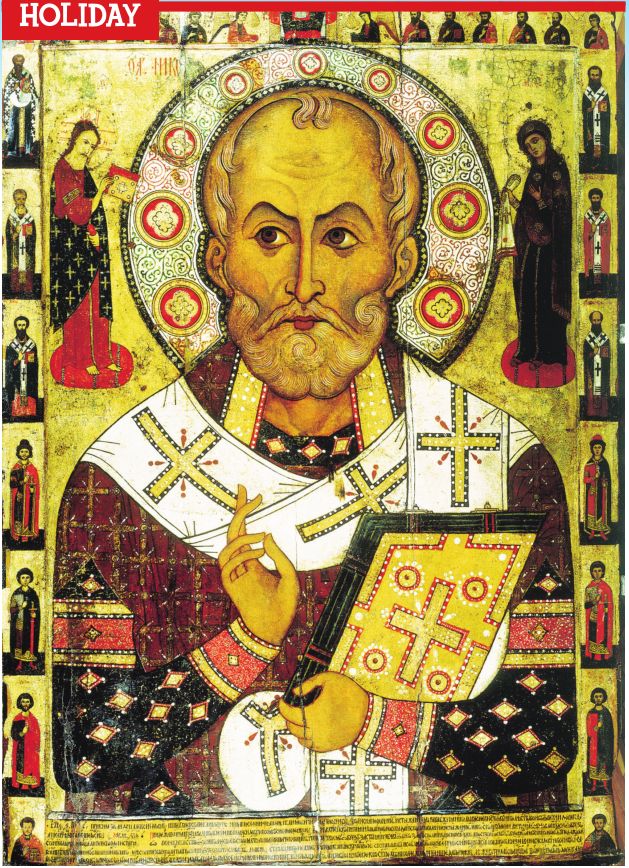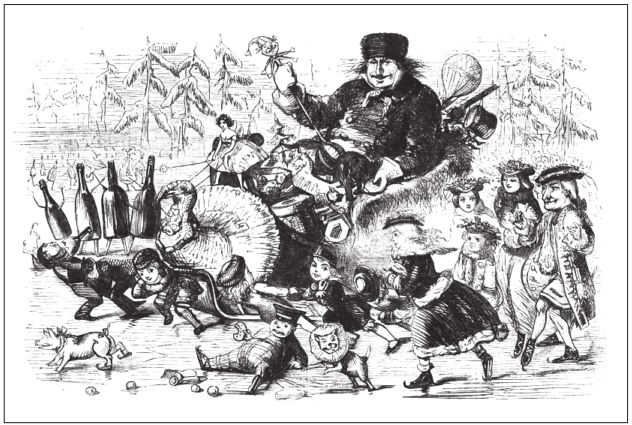
With children the annual return of that mysterious personage called “Santa Claus,” with his budget of gim cracks and appropriate presents, is full of excitement and is looked forward to with absorbing interest. Illinois State Journal, Dec. 25, 1856
In the 1850s, the arrival of December meant that stores in downtown Springfield would be filled with toys and gifts, and newspapers would be filled with ads reminding holiday shoppers that “Christmas is Coming.” Indulgent father that he was, Abraham Lincoln no doubt purchased goodies for his young sons, Robert, Willie and Tad, well aware that they were counting on Santa Claus to visit their house and fill their little stockings with treats and gifts.
This was not the case in Lincoln’s own childhood, when Santa Claus was not yet, as they say, “a thing.” As a boy, Lincoln likely hadn’t even heard of St. Nicholas. During the course of just one generation at the beginning of the 19 th century, St. Nick evolved from an obscure Dutch saint to the beloved American symbol for commercially tinged Christmas cheer.
The original Nicholas was the third-century bishop of Myrna, a small town in what is now Turkey. By about 1200 AD, he was associated with many miracles; one in particular earned him the reputation as the patron saint of children. According to legend, Nicholas visited an inn where the keeper had recently murdered and dismembered three boys and pickled their bodies in barrels. Sensing something wrong, Nicholas discovered the crime and resurrected the victims.
Throughout early modern
Europe, St. Nicholas Day (Dec. 6) was a day when the good saint brought
gifts to good little boys and girls. This practice fell out of favor in
many countries after the Protestant Reformation in the 16 th century,
but the Dutch clung fast to the tradition of St. Nicholas, whom they
called Sinter Klaas. When Dutch colonists settled in New York, they
brought their tradition with them.
Dutch-American St. Nicholas got a big boost in popularity with the publication of Washington Irving’s satirical Knickerbocker’s History of New York in
1809, which described St. Nicholas flying over housetops in a wagon and
dropping presents down the chimneys of good little children.
In 1821, The Children’s Friend became
the first book published in America to include lithographic
illustrations. This book included a poem about St. Nicholas that
embellished Irving’s version: Irving’s flying wagon became a flying
sleigh pulled by reindeer, and St. Nicholas arrived on Christmas Eve,
not St. Nicholas Day. With the publication of Clement C. Moore’s wildly
popular poem, “A Visit From St. Nicholas” (also known as “’Twas the
Night Before Christmas”), in 1823, the idea of Santa Claus really took
off in American popular culture.
This
magical Santa Claus of the 19 th century was instrumental in the
transformation of Christmas in American culture. In Colonial America,
Christmas traditions varied by religion and by region. To many
Protestant denominations, including Presbyterians, Baptists and Quakers,
Dec. 25 was a normal business day with no religious significance. In
New England, the celebration of Christmas was frowned upon by Puritans
who saw it as a pagan holiday. In the South and Middle Atlantic,
Anglicans, Catholics and Lutherans celebrated Christmas with both
religious observances and secular feasting and festivals. The latter
generally involved copious amounts of alcohol, leading to drunken mobs
roaming the streets and causing trouble.
Enter
the growing American middle class, who idealized the home, children and
pious devotion to God. This influential cultural group seized on the
Christmas holiday and domesticated it into an event centered around
traditions of family gatherings, religious worship and giving gifts to
children.
Santa Claus
was an ideal mascot for this new version of Christmas. The American
middle class had disposable income to spend, and they were living at a
time when the Industrial Revolution fostered the availability of
mass-produced consumer goods and improving transportation networks made
those goods readily accessible. Moreover, it was a time when children
were idealized and childhood was celebrated. Santa Claus gave parents
the perfect excuse to spend money on their little angels – though in
true moralistic 19 th century fashion, children had to behave well and
“be good” if they were to receive gifts.
Just
what their mythical benefactor looked like was largely up to their
imagination, for an image of Santa had not yet been codified in the
popular culture. In 1858, for example, Harper’s Weekly depicted
Santa as a beardless man with dark hair driving a sleigh pulled by a
turkey. Illustrator Thomas Nast is credited with standardizing the image
of Santa Claus as a plump, jolly, white-bearded elf in illustrations he
did for Harper’s Weekly between 1863 and 1886.
By
the mid-19 th century, Santa Claus was the undisputed anchor of the
Christmas holiday. Springfield fathers like John T. Stuart, who had
grown up without St. Nicholas, would find themselves braving snowstorms
on Christmas Eve to buy toys so the next morning they could have the
satisfaction of seeing that their children’s “eyes glistened when they
saw their little stockings all hung in an row and full of toys and
candies.”
Erika
Holst is Curator of Collections at the Springfield Art Association. She
delights in playing Santa Claus to her own little angel, Anders.